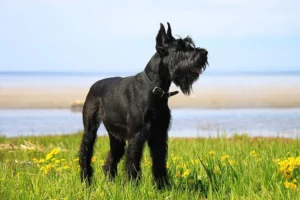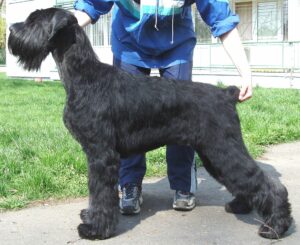Giant Schnauzer
Confident and dominant
History and General Information of Giant Schnauzer dog breed
The Giant Schnauzer is a large and powerful breed of dog that belongs to the Working Group. Known for their intelligence, loyalty, and versatility, they make excellent companions, protectors, and working dogs.
In terms of appearance, Giant Schnauzers are robust and muscular dogs with a distinctive look. They have a square-shaped body, a strong neck, and a deep chest. Their double coat consists of a wiry, dense outer coat and a soft undercoat. The most common colors for this breed are solid black or salt-and-pepper, which is a mix of black and white hairs.
As their name suggests, they are quite large. Males usually stand between 25.5 to 27.5 inches (65 to 70 cm) at the shoulder and weigh around 60 to 95 pounds (27 to 43 kg). Females are slightly smaller, ranging from 23.5 to 25.5 inches (60 to 65 cm) in height and weighing between 55 to 75 pounds (25 to 34 kg).
Giant Schnauzers are intelligent, loyal, and alert dogs. They are generally confident and have a dominant personality, making them excellent watchdogs and protectors of their family. Early socialization and training are crucial for them to ensure they develop into well-mannered and well-adjusted companions.
The breed’s history can be traced back to Germany in the 17th and 18th centuries. They were developed by crossing Standard Schnauzers with larger breeds like the Great Dane, Bouvier des Flandres, and the rough-coated shepherd dogs. The aim was to create a larger and more robust breed capable of working as a versatile farm dog, driving cattle, and guarding property.
Throughout history, the Giant Schnauzer has proven itself to be a versatile working breed. They were initially employed as herding and guarding dogs for farms and estates, but their skills were later adapted for police work and military service. In modern times, they excel in various dog sports, obedience competitions, and as search and rescue dogs.
The breed gained popularity beyond its native Germany in the 20th century and is now recognized by major kennel clubs worldwide, including the American Kennel Club (AKC), the United Kennel Club (UKC), and the Kennel Club (UK).
Giant Schnauzers are energetic dogs that require regular exercise to keep them physically and mentally stimulated. Daily walks, playtime, and training sessions are essential for their well-being. Additionally, their coat requires regular grooming to prevent matting and maintain its appearance.
Like all dog breeds, Giant Schnauzers are prone to certain health issues, including hip dysplasia, elbow dysplasia, and eye conditions. Responsible breeding practices and regular veterinary check-ups can help minimize the risk of these inherited health problems.
In summary, if you’re considering adding a Giant Schnauzer to your family, be prepared for their energetic nature, need for mental stimulation, and a commitment to training and socialization. With proper care, they can make wonderful companions for the right families or individuals.
Dog Breed Traits
Breed traits that should one consider before going through a list of all dog breeds for adoption or purchase.
Size: Large
Adaptability to your living environment: Needs space and exercise
Allergies: Some may have allergies
Friendliness towards family/known people: Very loyal and friendly
Behavior towards strangers (guarding trait): Reserved and cautious, good guard dogs
Friendliness towards kids: Generally good with kids
Hair/fur shedding: Moderate shedding
Activity/energy level: High energy, needs regular exercise
Life span: 10-12 years
The difficulty level of training them: Moderately challenging, requires consistent training
Behavioral history of the breed: Originally bred for herding and guarding, versatile working dogs
General health: Generally healthy, but prone to certain health issues like hip dysplasia and eye conditions
Available puppies
Giant Schnauzer available puppies






